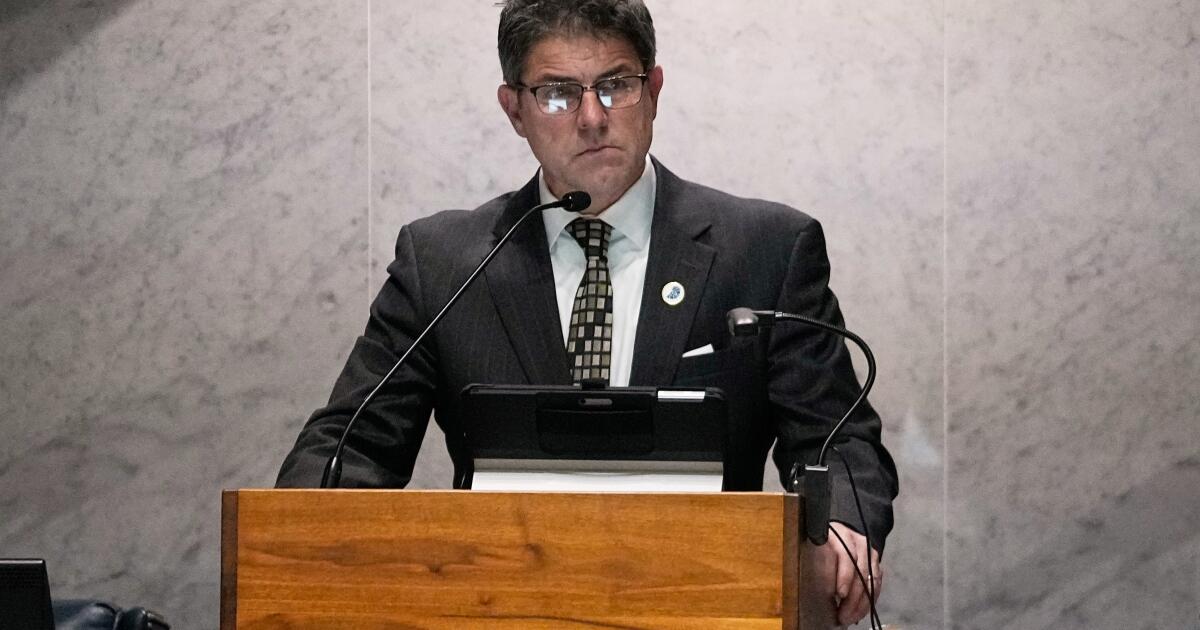Column: California’s sleazy redistricting beats having an unhinged president
SACRAMENTO — While President Trump was pushing National Guard troops from city to city like some little kid playing with his toy soldiers, California Gov. Gavin Newsom was coaxing voters into fighting the man’s election-rigging scheme.
It turned out to be an easy sell for the governor. By the end, Californians appeared ready to send a loud message that they not only objected to the president’s election rigging but practically all his policies.
Trump is his own worst enemy, at least in this solidly blue state — and arguably the California GOP’s biggest current obstacle to regaining relevancy.
Here’s a guy bucking for the Nobel Peace Prize who suggests that the country resume nuclear weapons testing — a relic of the Cold War — and sends armed troops into Portland and Chicago for no good reason.
The commander in chief bizarrely authorized Marines to fire artillery shells from a howitzer across busy Interstate 5. Fortunately, the governor shut down the freeway. Or else exploding shrapnel could have splattered heads in some topless convertible. As it was, metal chunks landed only on a California Highway Patrol car and a CHP motorcycle. No injuries, but the president and his forces came across as blatantly reckless.
And while Trump focused on demolishing the First Lady’s historic East Wing of the White House and hitting up billionaire grovelers to pay for a monstrous, senseless $300-million ballroom — portraying the image of a spoiled, self-indulgent monarch — Newsom worked on a much different project. He concentrated on building a high-powered coalition and raising well over $100 million to thwart the president with Proposition 50.
The ballot measure was Newsom’s and California Democrats’ response to Trump browbeating Texas and other red states to gerrymander congressional districts to make them more Republican-friendly. The president is desperate to retain GOP control of the House of Representatives after next year’s midterm elections.
Newsom retaliated with Prop. 50, aimed at flipping five California House seats from Republican to Democrat, neutralizing Texas’ gerrymandering.
It’s all sleazy, but Trump started it. California’s Democratic voters, who greatly outnumber Republicans, indicated in preelection polling that they preferred sleazy redistricting to an unhinged president continuing to reign roughshod over a cowardly, subservient Congress.
A poll released last week by the UC Berkeley Institute of Governmental Studies found that 93% of likely Democratic voters supported Prop. 50. So did 57% of independents. Conversely, symbolic of Trump’s hold on the GOP and our political polarization, 91% of Republicans opposed the measure.
Similar partisan voting was found in a survey by the Public Policy Institute of California. Pollster Mark Baldassare said that “96% of the people voting yes on 50 disapprove of Trump.”
Democrats — 94% of them — also emphatically disapproved of the Trump administration’s immigration raids, the PPIC poll showed. Likewise, 67% of independents. But 84% of Republicans backed how the U.S. Immigration and Customs Enforcement Agency was rounding up people living here illegally.
ICE agents shrouded in masks and not wearing identification badges while traveling in unmarked vehicles — raiding hospitals, harassing school kids and chasing farmworkers — are not embraced in diverse, immigrant-accepting California.
When the PPIC poll asked voters how undocumented immigrants should be handled, 69% — including 93% of Democrats — chose this response: “There should be a way for them to stay in the country legally.” But 67% of Republicans said they should be booted.
The ICE raids were among the Trump actions — and flubs — that helped generate strong support for Prop. 50. It was the voters’ device for sticking it to the president.
“Californians are concerned about the overreach of the federal government and that helped 50,” Democratic consultant Roger Salazar says. “It highlights how much the Trump administration has pushed the envelope. And a yes vote on Prop. 50 was a response to that.”
Jonathan Paik, director of a Million Votes Project coalition that contacted 2 million people promoting Prop. 50, says: “We heard very consistently from voters that they were concerned about the impact of Trump’s ICE raids and the rising cost of living. These raids don’t just target immigrants, they destabilize entire communities and deepen economic struggles.
“Voters saw Prop. 50 as a way to restore balance and protect their families’ ability to work, pay rent and live safely.”
The measure also provided a platform for Democratic U.S. Sen. Alex Padilla of California to explore possibly joining a crowded field of candidates running for governor. Newsom is termed-out after next year.
The Trump administration did Padilla a gigantic favor in June by roughing up the senator and handcuffing him on the floor when he tried to query Homeland Security Secretary Kristi Noem during a Los Angeles news conference about ICE raids. Such publicity for a politician is golden.
Padilla became a leading advocate for Prop. 50 while seriously considering a gubernatorial bid. The senator said he’d decide after Tuesday’s special election.
“I haven’t made any decision,” he told me last week. “Sometime in the next several weeks.”
But it’s tempting for this L.A. native, the son of Mexican immigrants who was inspired to enter politics by anti-immigrant bashing in the 1990s.
“I’d have an opportunity and responsibility to be a leading voice against that,” he said. “California can be a leader for the rest of the country on immigration, environmental protection, reproduction quality, healthcare…”
In many ways it already is. But Trump hates that. And California Republicans step in it by meekly following the hugely unpopular president. Prop. 50 is the latest result.
California Republicans can do better than behave like Trump’s wannabe reserve toy soldiers.
What else you should be reading
The must-read: A youth movement is roiling Democrats. Does age equal obsolescence?
The what happened: Most Americans have avoided shutdown woes. That might change.
The L.A. Times Special: Voters in poll side with Newsom, Democrats on Prop. 50 — a potential blow to Trump and GOP
Until next week,
George Skelton
—
Was this newsletter forwarded to you? Sign up here to get it in your inbox.








